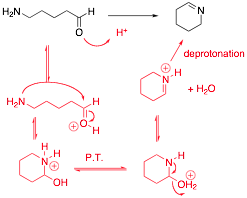Quiz 4 Answer Key
- Page ID
- 10489
1. Multiple Choice and fill-in-the-blank: Put best answer in the box provided.
Q1a
Which of the following statements is FALSE about Mass Spectrometry
a) MS can be used to determine the molecular formula of a compound
b) MS can be used to determine the amino acid sequence of a protein
c) MS can be used to determine the stereochemistry of a compound
d) MS can be used to determine if a compound contains a bromine
S1a
c) MS can be used to determine the stereochemistry of a compound
Q1b
Which of the following conditions is not used for reducing carbonyls or imines:
a) NaBH3CN
b) NADH with alcohol dehydrogenase
c) Ag2O, H2O, NaOH
d) NaBH4
e) H2NNH2, KOH, diethylene glycol
f) Ni catalyst with H2
S1b
c) Ag2O, H2O, NaOH
Q1c
Which of the following synthesis conditions will not produce a carbonyl compound?
a) alkyne + BH3, followed by H2O2 and NaOH
b) primary alcohol + PCC
c) alkene + O3, followed by SMe2
d) imine + water and acid catalyst
e) alkyne + Pd/C
S1c
e) alkyne + Pd/C
Q1d
In the formation of an acetal or an imine, a molecule of _H2O__ is also produced.
Q2
The a-hydrogen of a carbonyl has a pKa of ~20, compared to most alkanes that have a pKa of ~50. This acidity is very important for synthetic transformations that we will soon be discussing. Draw the conjugate base that results when an aldehyde is treated with a generic base (such as NaOH), and explain why the aldehyde has increased acidity relative to other alkanes.

The anion can be stabilized through resonance.
(must show resonance structure for full credit!)
Q3
Predict the major product(s) for each of the following reactions.
Place your answer in the box provided.



Q4
An unidentified carbonyl compound with molecular formula C5H10O was mixed with an mystery alcohol and acid to make a new product. The carbonyl compound gives a negative Tollen’s test. The 1H NMR spectrum of the product is provided below. With this information, provide the structure for each of the reaction components and put your answers in the boxes provided.


1H NMR of the product (number of hydrogens based on integration):

Q5
Provide a reasonable arrow pushing mechanism for the following reaction:

Q6
Propose an efficient synthesis for the following molecule using the starting materials indicated.


